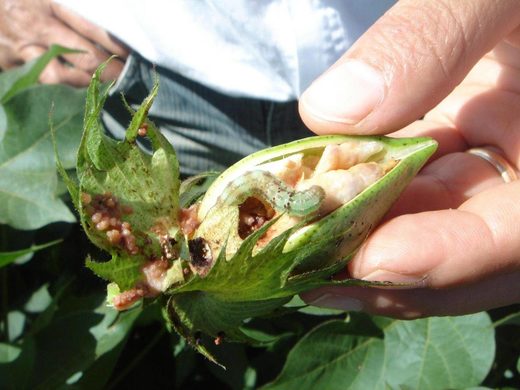
New strain could be significant biosecurity risk and has potential to go 'completely undetected'
A pair of major agricultural pests have combined to produce a "mega-pest" that could threaten crops around the world.
Losses from the original pest species, cotton bollworms and corn earworms, already amounts to billions of dollars worth of food.
But a hybrid of the two, shows signs of rapidly developing resistance to pesticides and it scientists fear it could cross international boundaries undetected, wiping out all the crops it comes across.
Bollworms and earworms are closely related. The bollworm has its origins in Africa, Asia and Europe while the earworm is a native of the Americas.
Both are in fact moth caterpillars and they feed on more than 100 plant species including vital crops like corn, cotton, tomato and soybean.
A team of Australian scientists who discovered the hybrid mega-pests think the combination of international species could be creating a new strain with unlimited geographical boundaries.
It is impossible to tell which individuals are hybrids just by looking at them, meaning by the time the hybrids have been detected it may be too late.
"A hybrid such as this could go completely undetected should it invade another country," said Dr Paul De Barro, a biosecurity expert at Australia's Commonwealth Scientific and Industrial Research Organisation (CSIRO).
The scientists studied nine from Brazil and found that every one was a hybrid.
"No two hybrids were the same suggesting a 'hybrid swarm' where multiple versions of different hybrids can be present within one population," said Dr Tom Walsh, a CSIRO researcher who undertook the study.
But while Dr Walsh and his colleagues observed the hybridisation happening in Brazil, they suggested it could have severe consequences for Australia - a nation that has had its fair share of problems with invasive species.
Australia already has its own species of bollworm and Dr De Barro warned there was no room for complacency when considering future biosecurity risks.
"It is critical that we look beyond our own backyard to help fortify Australia's defence and response to biosecurity threats," said De Barro. "As Australia's national science agency, we are constantly looking for new ways to protect the nation and technology like genome sequencing, is helping to tip the scales in our favour."
The mega-pest discovery was documented in the journal Proceedings of the National Academy of Sciences.
In Australia, a combination of pesticides is currently being employed to manage the nation's bollworms, but chemical resistance is a major cause for concern.
Bollworms are generally better at developing resistance than their earworm cousins, and are immune to the effects of many major insecticides.
However, within the "hybrid swarm" they studied in Brazil the scientists found creatures that were largely earworm in their genetic makeup, but with bollworm DNA coding for pesticide resistance.
The scientists warned that the Brazilian case highlighted the threat that new "agriculturally problematic" strains of pest could soon spread throughout the rest of the Americas.
"On top of the impact already felt in South America, recent estimates that 65 per cent of the USA's agricultural output is at risk of being affected by the bollworm demonstrates that this work has the potential to instigate changes to research priorities that will have direct ramifications for the people of America, through the food on their tables and the clothes on their backs," said Dr Craig Anderson, one of the study's authors.



Reader Comments